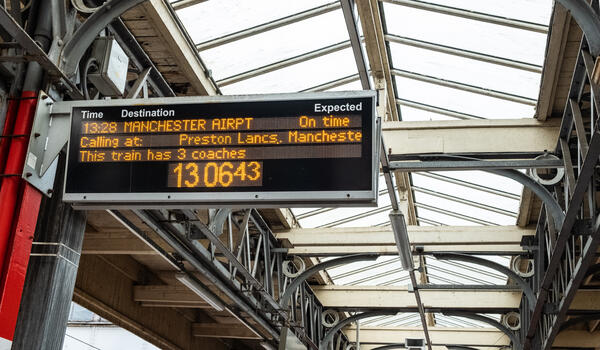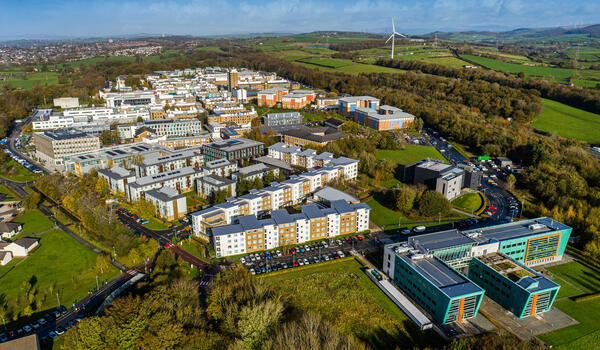Lancaster University’s Climate Emergency Carbon Reduction Plan (CECRP) has been produced to provide a strategic route map, detailing how the University proposes to reduce its carbon emissions through the implementation of a range of projects, policies, education and behaviour change.

Reducing Carbon Emissions
Scroll to content
-
Scope 1 & 2 emissions
Greenhouse gas emissions are classified into three principal types or “scopes”. Scope 1& 2 emissions are the result of energy consumption or import (principally comprising gas and electricity consumption).

-
Scope 3 emissions
Scope 3 emissions are emissions from all other activities, specifically travel emissions and procurement emissions (from the purchase of goods & services).

Climate Emergency Declaration
Whilst implementation of projects in the CMP has been very successful, delivering substantial reductions in carbon emissions, and achieving the 2020 carbon reduction target, the rapid increases in atmospheric carbon and impacts of global warming have emphasised the need to more rapid and comprehensive action to address all emission sources.
In recognition of the increasing urgency to respond to climate change, internal staff and student pressure and the scientific and HE sector consensus that rapid action was imperative, Lancaster University declared a climate emergency in November 2020. The Declaration of Climate Emergency commits Lancaster University to becoming ‘net zero’ from Scope 1 and 2 carbon emissions (mainly from electricity and gas consumption) by 2030 and ‘net zero’ from scope 3 (from transport and procurement) by 2035. The targets are ‘science based’ in that they reflect the urgency of the task to reduce carbon emissions as rapidly as possible.
Lancaster University Carbon Footprint
Lancaster University’s total carbon footprint from its activities and operations in 2019-20 was 70,660tonnes CO2e. Emissions from Scope 1 & 2 sources (primarily electricity and gas consumption) comprised 11,689t CO2e or 17% of the total. Of University Scope 3 emissions, those relating to transport comprised 19,850t CO2e, or 28% of the total, with procurement accounting for 39,121t CO2e, or 55% of total emissions. A breakdown of Lancaster University Carbon Footprint is presented on Figure X (not included at present).
| 16% | Scope 1 & 2 |
| 27% | Scope 3 - Travel |
| 57% | Scope 3 - Procurement |
Carbon Reduction Projects
The University is revising its strategic approach to sustainability and has already reduced it's heating and electricity emissions by more than 50% since 2005. Take a look at the University's upcoming and current projects, aimed at reducing carbon and improving the environment.

Travel Decision Tree
To encourage sustainable business and academic travel amongst staff, we have implemented a Travel Decision Tree, which was designed by academics from the Lancaster Environment Centre. The decision tree encourages people to look at alternatives to high carbon-emitting travel options like flights, and choose public transport, online events or a reduction in the amount of people travelling to one event.

Sustainable procurement
Carbon emissions from procurement activities are the most significant category of emissions at Lancaster University comprising 57% of total carbon emissions. The procurement team are currently undertaking a large audit of supply chains to ensure we reduce the emissions in this area. We are currently working with suppliers to help them understand their carbon impacts and providing carbon impact training and information (carbon dashboards) internally to staff with procurement responsibilities.

Electric vehicle fleet
Two-thirds of the University's vehicle fleet is now electric - and we are committed to increasing this wherever possible. There are also over 30 electric vehicle charging points for staff, students and visitors, plus cheaper parking rates for staff with electric cars.

Reducing construction
Comprising up to 20% of total University emissions, construction-related emissions are the most significant University carbon emissions source. As we advance, the University will minimise the amount of construction, through the refurbishment of existing buildings and facilitation of ‘agile working’ in order to reduce future campus space requirements. We will also review construction materials' use and embedded carbon content to seek alternative lower carbon, sustainable products.

Reducing food waste
The Food & Dining team at Lancaster have made significant progress in reducing carbon emissions from food sold on campus through internal catering or in our cafes. One way they have done this is by reducing food waste. Many of the cafes on campus are signed up to Too Good to Go, where any leftover food at the end of the day, is sold at a discounted price through the app - reducing food waste and helping students grab a bargain!
Finance, Governance & Reporting
Under the delegated authority of the University’s Vice-Chancellor, responsibility for the implementation and review of the CEP rests with the Climate Emergency Task & Finish Group. The Task and Finish Group report to University Executive Board (UEB), Vice-Chancellor and Council on the progress in implementing the CEP
Through the Pro-Vice-Chancellor Global (Digital, International, Sustainability) the Climate Emergency Task & Finish Group makes recommendations to the UEB to ensure targets can be met.
Delivery of the CEP will require substantial investment in carbon reduction projects and initiatives from present to 2030 and 2035.




